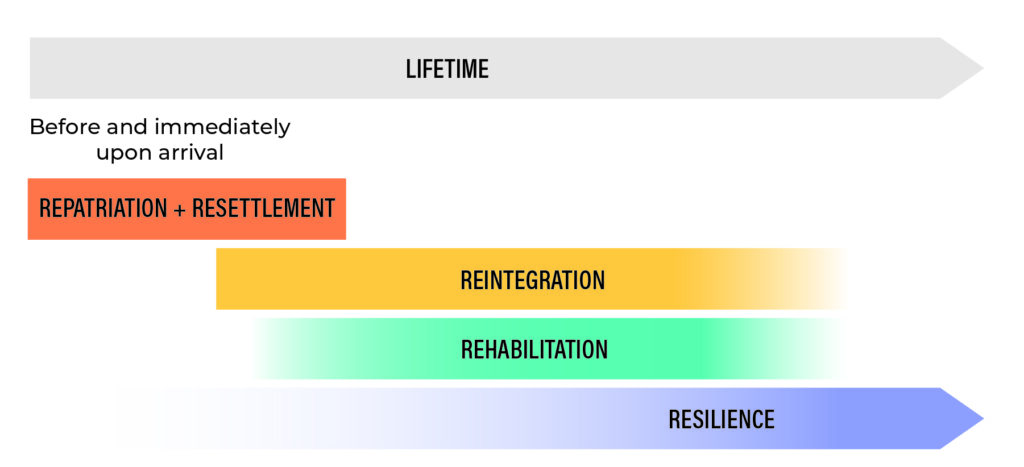Countries around the world must determine how to manage the return of women and children from formerly ISIS-controlled territories. The practice of supporting returning individuals is often referred to as ‘R&R,’ yet through a broad review of these programs and their related practices; we found that there was little agreement on what comprises R&R and even on what R&R stood for; the 2 ‘Rs’ variously referenced Reintegration, Rehabilitation, and Repatriation. Our review of existing programs and literature suggests that these programs are better described as operating across ‘5 Rs’: Repatriation, Resettlement, Reintegration, Rehabilitation, and Resilience. In this brief, we describe these 5R domains.
5Rs: REPATRIATION, RESETTLEMENT, REINTEGRATION, REHABILITATION, RESILIENCE
The theory of change –a statement describing the problem, its underlying assumptions, necessary
activities, and desired outcomes– for the 5R framework is as follows:
Theory of Change: Women and children returning from formerly violent extremist conflict have been exposed to trauma and adversity. They also face challenges upon returning to their countries of origin, including ruptured social networks, family conflict, community stigma, challenges of acculturation and resettlement stress, and identity conflicts with surrounding society. Unless these challenges are addressed, returning women and their children remain vulnerable to forming, retaining, or re-establishing ties with violent extremist networks as a means of fulfilling some or all of their needs. Thus, programming that addresses personal safety and wellbeing, promotes belonging and opportunity, and supports development of non-violent skills and attitudes will contribute to disengagement from—or decreased likelihood of engaging with—violent extremist groups and ideologies.
Four domains of activities – spread across five ‘R’s – capture complementary but discrete goals of best
practice programming supporting returning women and children.

Different stakeholders may be involved in different ways across the domains (see ‘inputs), and specific activities can conform to specific contexts where the programs are delivered. Activities within each domain target different core components that are expected to contribute to the desired outcomes.
A brief summary of each of the 5R domains is presented below. 5R programming should be tailored to specific settings: implementers of 5R programming can use these descriptions as a framework for considering program elements and can tailor it to their context by asking questions such as “How does this fit our context? What needs to change? What specific strengths and assets from this context can contribute to a robust 5R program? What domains are already in place, and what areas could use
further development?”
The first 2Rs: Repatriation and Resettlement

Under UNHCR guidelines, repatriation refers to refugees returning voluntarily to their country of origin, whereas resettlement refers to the transfer of refugees to a third country that has granted them permission to stay. Repatriation and Resettlement activities must generally come first; overwhelming systems and individuals with too many additional interventions before basic needs are established is unlikely to be helpful and may even be seen as burdensome. Therefore, activities pre- and peri-arrival should focus on the basic components of physical, legal, and material safety.
The 3rd R: Reintegration
The UNHCR refers to reintegration as “the achievement of a sustainable return – in other words, the ability of returning refugees to secure the political, economic, [legal], and social conditions needed to maintain life, livelihood, and dignity.” These reintegration activities logically follow the resettlement phase for women and children, though some overlap is anticipated as the goal is to transition families from government-led supports to sustainably meeting their own social, health, and financial needs.
The 4th R: Rehabilitation

Rehabilitation broadly refers to ‘recovery,’ yet in the context of returning women and children, rehabilitation most closely parallels the idea of reducing the risk of engaging or re engaging in violent extremist activities. Rehabilitation activities, both in terms of timing and content, will be highly variable depending on the needs of the individual. While all returning women and children may benefit from some ongoing activities that support their development of healthy social relationships in mainstream communities, a subset of women may need more focused violence prevention or disengagement activities.
The 5th R: Resilience

Resilience as a psychological concept refers to the capacity to adapt in the face of adversity, including trauma, loss, and stress. Upon facing adversity, resilience can involve either a rapid return to baseline or, at times, profound personal growth. While resilience is listed last in this framework, resilience-building activities may occur and have benefits at any point in the 5R process. Some aspects of resilience (e.g., emotional health, self-esteem) may be critical to basic tasks such as economic integration; other aspects (e.g., openness to diversity, sense of belonging) may provide the necessary psychological shift that allows for non-violence and disengagement. Thus, resilience activities are not just desirable but may instead be the necessary mechanisms allowing integration and non violence to occur.
Key Principles of 5R Framework
• Trauma-informed
• Holistic/whole-of-society
approaches
• Gender-sensitive
• Developmentally sensitive
• Human rights oriented
• Person-centered
• Culturally-responsive
• Strengths-based
Future Directions of 5R Programming
The 5R model provides a framework to illustrate how recommended best practices could be employed by countries seeking to support individuals returning from formerly ISIS-controlled territories. Ultimately, best practices will be defined through the development, evaluation, and sharing of programs that do this work. We invite practitioners around the globe to become partners in refining, elaborating, and disseminating the 5R framework in the service of improving approaches to fostering non-violence and protecting human rights.



